Pine Mountain Settlement School
Series 37: WEAVING
Series 32: OBJECT COLLECTIONS
Weaving and Fireside Industries
1913-present
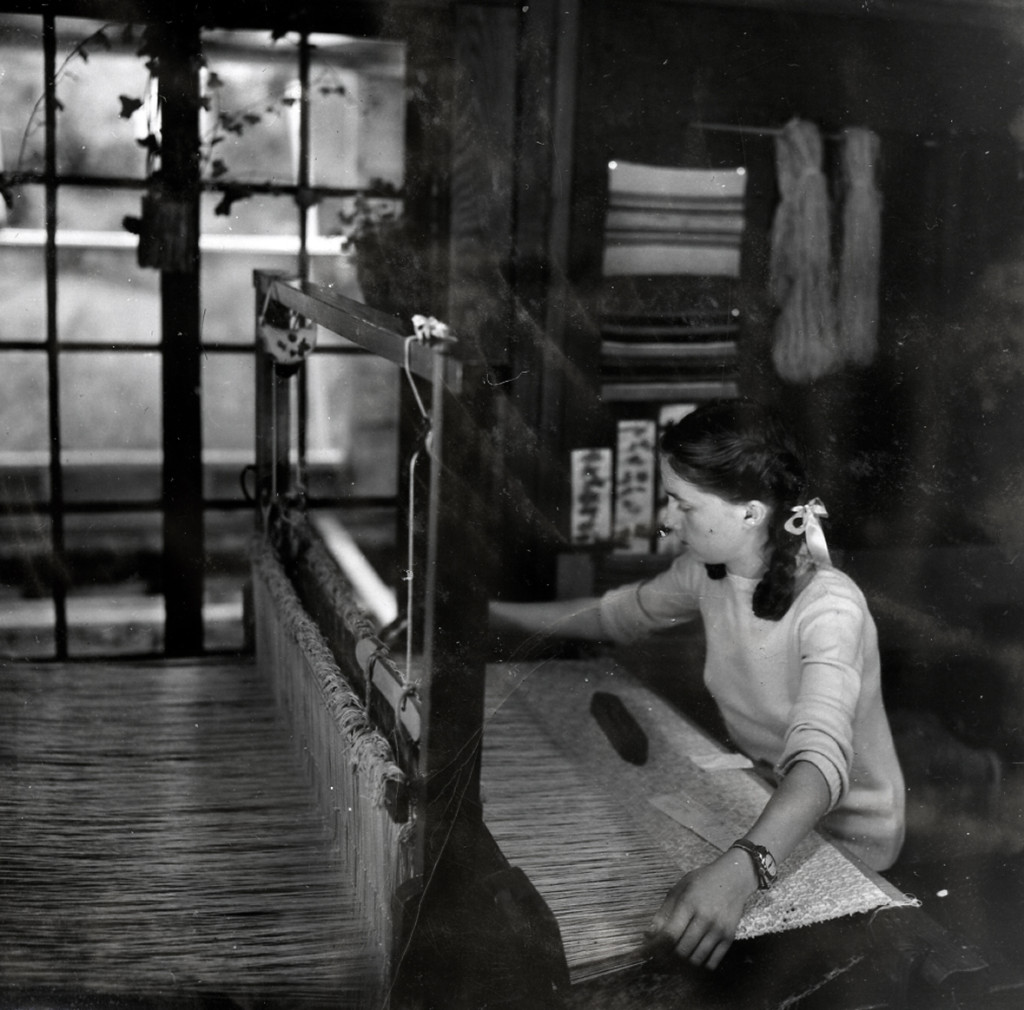
Geraldine Boggs, weaving. [nace_1_060c.jpg]
TAGS: weaving, Fireside Industries, blue-pot, sheep wool, vegetable dyeing, flax, industrial arts, basket weaving, baskets, looms, homespun
WEAVING Fireside Industries and Weaving at PMSS
WEAVING: Early Years
Weaving has been an integral part of Pine Mountain Settlement School’s educational focus through most of its historical course. The large number of looms held by the institution and the rich heritage and tradition of weaving in the community have worked to keep the craft alive at the school for over 100 years.
One of the most important influences on the weaving tradition at the school may be summed up in one name: PETTIT. It was Katherine Pettit, one of the founders of the institution that permanently linked the craft to the work of the settlement institution. Even as Pettit searched for a location for a new settlement school, she was searching for unique weavings in the many cabins and trunks of mountain homes. Many of the families were descendants of guild weavers who came with the first settlers to America from the Borderland of Scotland and from Ulster, in Ireland and from the Lowlands of Flanders and the Netherlands.
Many of the early immigrants to America brought with them their weaving patterns, their knowledge of processing flax, of growing and processing indigo for “blue-pot” and the many processes for obtaining dyes from other natural sources. When educational programs were fully established, the School was influenced by the growing interest in the marketing of the crafts through a program called “Fireside Industries. ” The interest in Appalachian crafts was stimulated by exhibitions and growing markets in the nations larger cities.
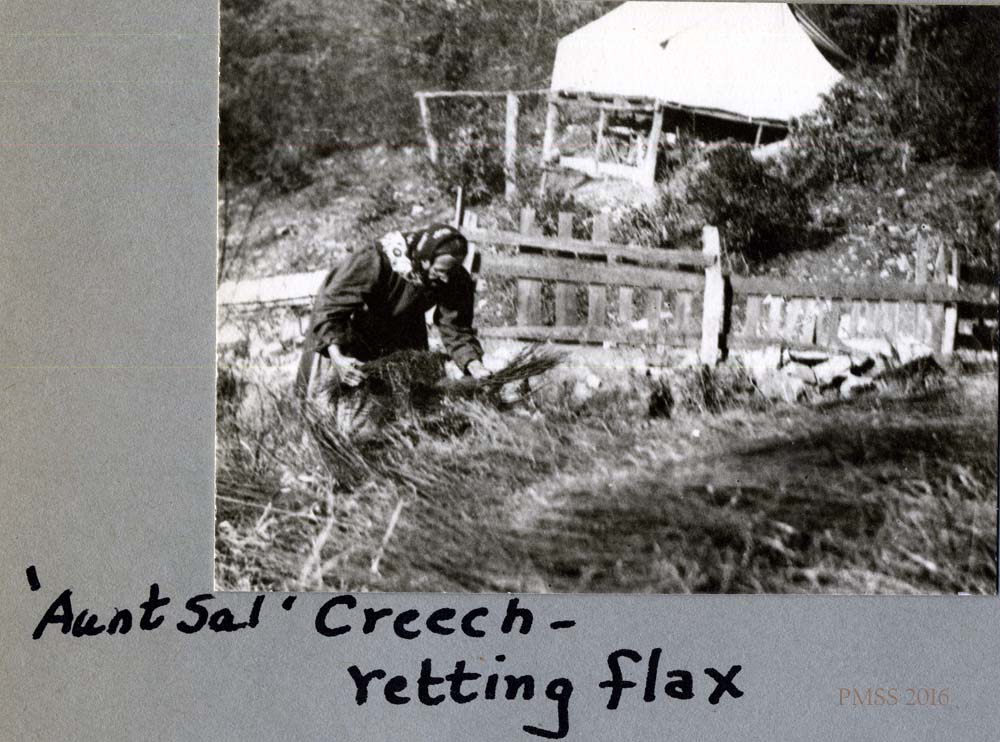
“‘Aunt Sal’ Creech – retting flax.” [nace_II_album_059.jpg]
The movement was continued into the 1930s and early 1940s, stimulated in part by the publication of Allen H. Eaton’s publication Handicrafts of the Southern Highlands: With an Account of the Rural Handicraft Movement in the United States and Suggestions for the Wider Use of Handicrafts in Adult Education and in Recreation (1937). Eaton, in his introduction to the book quotes Aunt Sal Creech and Uncle William
“Weaving, hit’s the prettiest work I ever done. It’s asettin’ and trampin’ the treadles and watchin’ the pretty blossoms come out and smile at ye in the kiverlet.”
“Hit’s better for folkses characters to learn ’em to do things with their hands.”
[AUNT SAL CREECH, of Pine Mountain, Kentucky and UNCLE WILLIAM CREECH of Pine Mountain, Kentucky]
The Creech couple share the quote page with Robert Henri, Charles Eliot, William Morris, and this timely quote by Franklin D. Roosevelt, President of the United States.
We of the United States are amazingly rich in the elements from which we weave a culture. We have the best of man’s past on which to draw, brought to us by our native folk and folk from all parts of the world. In binding these elements into a national fabric of beauty and strength let us keep the original fibers so intact that the fineness of each will show in the completed handiwork.
FRANKLIN D. ROOSEVELT
Fireside Industries, under the early direction of Pettit and the talents of staff and community, adopted the program at Pine Mountain in 1913, the first year of the School’s history. It accounted for a substantial income for the School in its early years. With the ready labor of residential and community students weaving, the program thrived until the Boarding School ended in 1949. Evelyn Wells describes the Fireside Industries program from 1913 -1928

The idea behind the development of this department has been to preserve all that was beautiful in the old mountain dyeing and weaving, letting only those things develop out of them that grew naturally, rather than to bring in outside ideas which did not belong to the mountains. Thus, we have used homespun wool, instead of that sent to the factory to be spun, and have avoided mercerized cotton and have religiously followed the old recipes for our dyes, never permitting the use of aniline dyes. that we are one of the few places in the mountains to appreciate to the full the artistic value of the old dyes, made of barks, roots and herbs, is evident from the fact that every weaving teacher who has come to us, has had to learn about the dying here.
Before there was any organized department, Miss Helen Wilmer Stone, housemother at Farm House for eight years, worked away at the dyeing and spinning as a sideline, losing no chance to get a recipe from a neighbor, or collect some beautiful piece of weaving, bartering old clothes for wool and the labor of preparing it, and one summer setting up a loom at Far House.
It was very early decided that when the Old Log House should be free of the hospital and the office and a family of children, it should be used for the weaving department. In 1921 this arrangement was possible, and Arlena Hall, Becky May Huff, Rhoda Melinda Lewis, Ralph Triplett and one or two others, went to weaving there. After a year, however, it was discovered that the place was too cold and dark and crowded for weaving, and the department reluctantly abandoned it for the present Library of the Schoolhouse. In 1924 it entered its present quarters in the new Girls’ Industrial Building.
The salary of the weaving teacher was paid for four years by the Southern Industrial Educational Association in Washington, but the breaking up of that organization terminated this arrangement. For the last two years, the Colonial Coverlet Guild of America [See Margaret Motter Talk for the Colonial Coverlet Guild of America] has contributed towards this salary.
In 1921 the baskets, made for us for years by Mr. and Mrs. Wiliam Causey and sold by the office, were transferred to the Fireside Industries Department for handling.
In 1926 the Fireside Industries accounts were taken off the books of the School, to be kept independently by that Department.
Evelyn K. Wells Record 13 – Fireside Industries
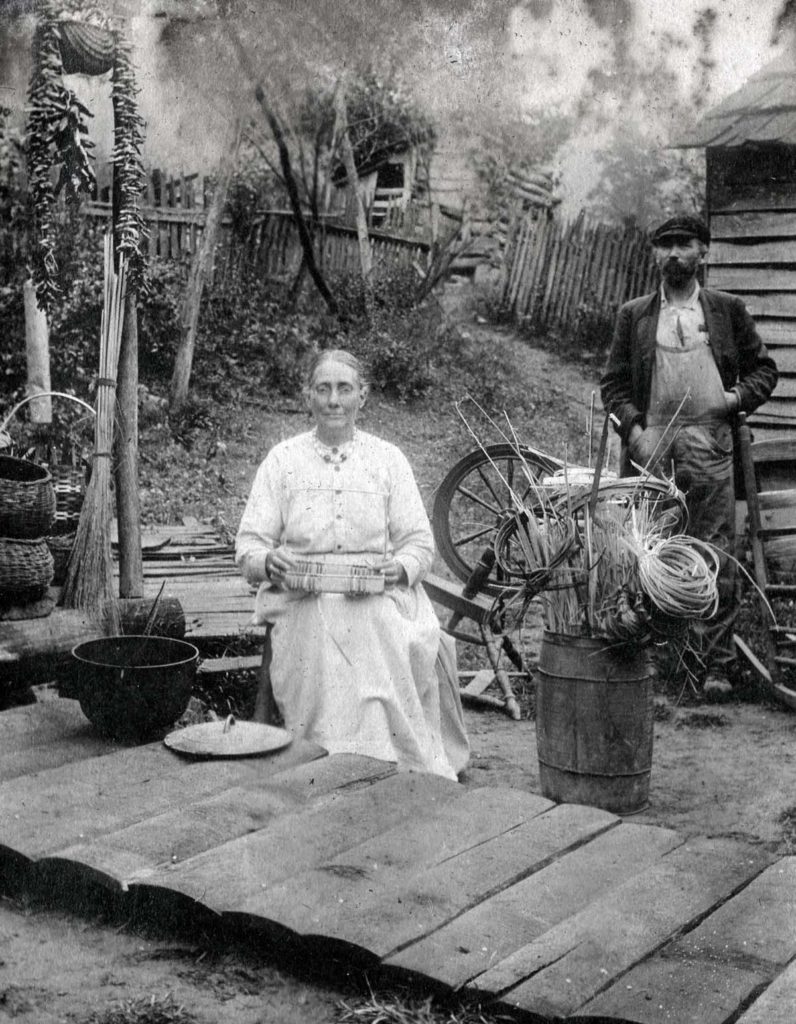
[melv_II_album_099x.jpg]
FIRESIDE INDUSTRIES SCRAPBOOK
Another item in the archive, a scrapbook titled “Fireside Industries” also reveals much about the influences on the early weaving industry at the School and within the Fireside Industries movement. It reflects the interests of the staff in the weaving of Native peoples around the world and highlights the industrial gain of many of those populations.
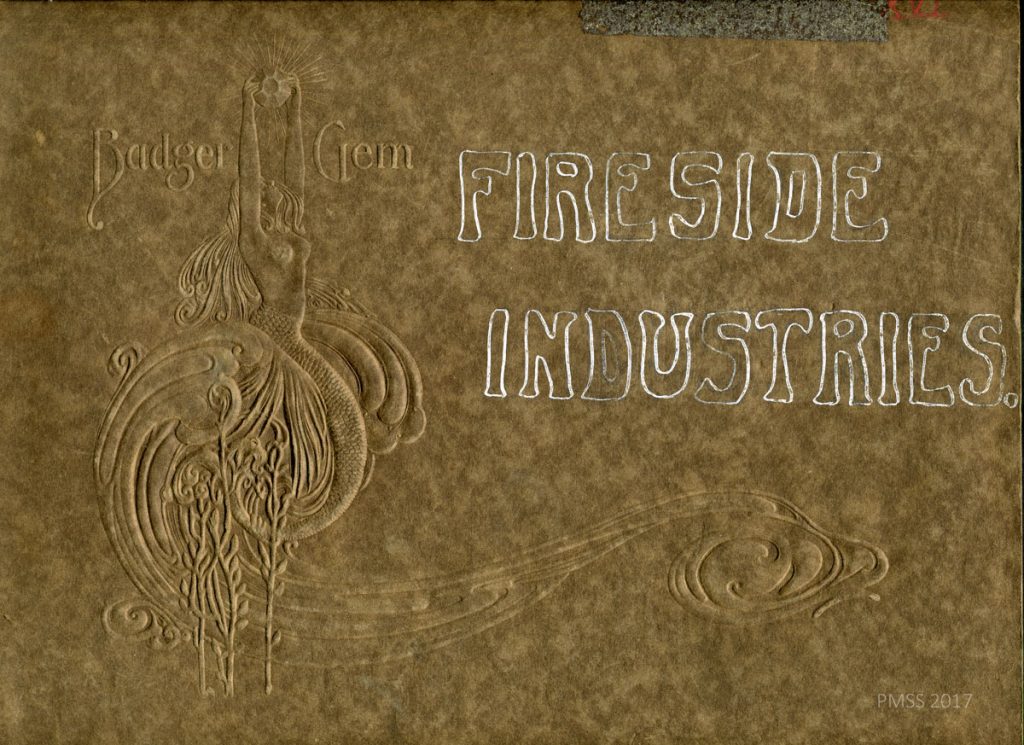
“Fireside Industries” Scrapbook Cover. [fireside_indust_cover1.jpg]
WEAVING: Later Years
Berea College, a leader in the Fireside Industries initiative, had a deep interest in the work at Pine Mountain and later became a major force in the shaping of the educational future of the School through the engagement of the President of Berea and other staff who were situated on the Board of Trustees of the mountain settlement school. However, many of the leaders in Berea’s weaving program who were recruited as consultants and collaborators in making weaving a part of the income stream of the institution began to fall away from their support of outlying programs, such as that at Pine Mountain and at other remote locations, following WWII.
In 1949, the Pine Mountain Settlement School became part of the Harlan County Schools and weaving was not a major player in the mandated State curriculum and became a craft activity and an after-school program.
When the Community School moved off the campus of Pine Mountain Settlement and the School began to develop short-term residential programs such as that of the Environmental Education program and the Intervention Program during the 1970s and 1980s, weaving again was integrated into program planning. During these years the large number of looms were rehabilitated and brought into service as part of the programming. The weaving studio was re-located to a large well-lit classroom in Draper Building and attempts were made to rehabilitate the weaving studio.
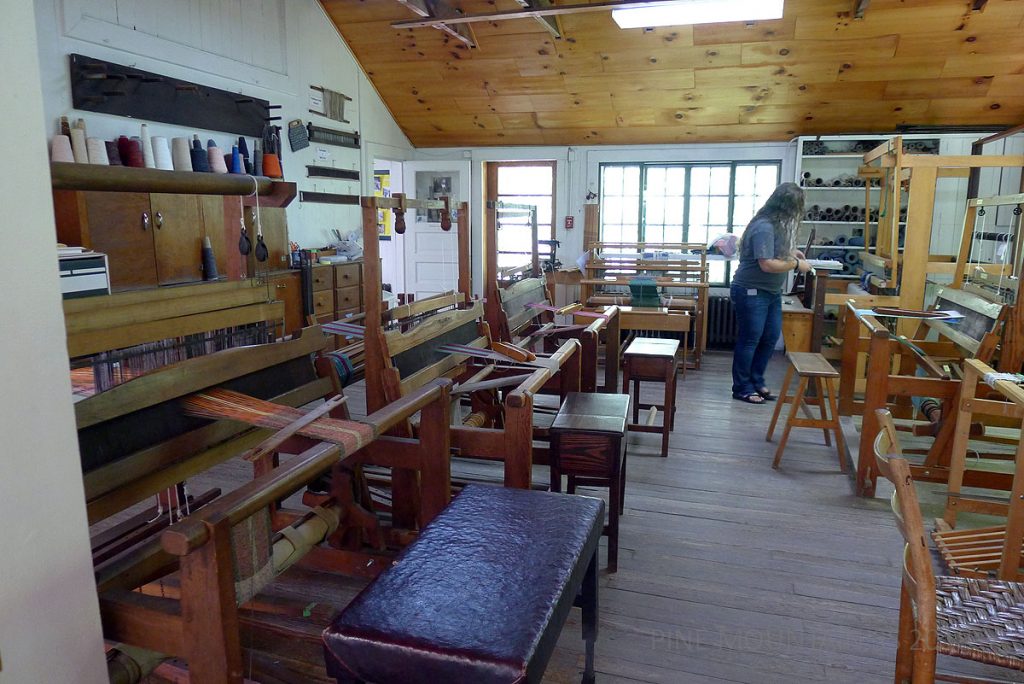
Weaving Studio at PMSS. [P115021.jpg]
Today, a full weaving studio is in place and many children who participated in the programming of the Environmental Education classes can recall their first introduction to a loom and the process of weaving. The well-equipped studio has great potential to become a major center for Appalachian weaving. In combination with agricultural programs such as sheep-farming, the handicrafts that found so many admirers promise a strong return as an educational tool. Charles Eliot, quoted in the Eaton book reminds us:
We have lately become convinced that accurate work with carpenters’ tools, or lathe, or hammer and anvil, or violin, or piano, or pencil, or crayon, or camel’s hair brush, trains well the same nerves and ganglia with which we do what is ordinarily called thinking…
CHARLES ELIOT [Selected as President of Harvard University in 1869 and credited with moving it to a leading research institution.]
The following pages will be of interest to readers looking for information on the weaving program(s) at Pine Mountain and the many products and lives that are the fabric of the looms of the institution.
See Also:
PUBLICATIONS PMSS EPHEMERA Department of Fireside Industries Brochure
BECKY MAY HUFF Student Staff – Biography
DANCING IN THE CABBAGE PATCH Weaving at PMSS 1930s-1940s
KATHERINE PETTIT Weaving at PMSS Beginnings
MARGARET MOTTER Talk: Colonial Coverlet Guild of America
WEAVING Samples at Pine Mountain Settlement School I
WEAVING Samples at PMSS II (Blue Tub)

